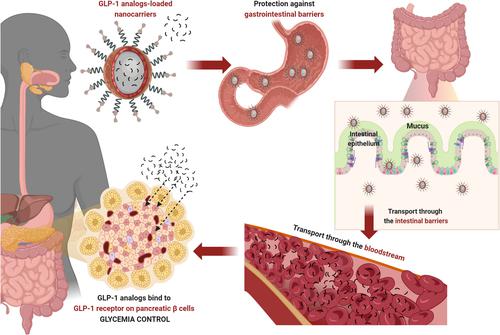当前位置:
X-MOL 学术
›
WIREs Nanomed. Nanobiotechnol.
›
论文详情
Our official English website, www.x-mol.net, welcomes your feedback! (Note: you will need to create a separate account there.)
New insights into nanomedicines for oral delivery of glucagon-like peptide-1 analogs
WIREs Nanomedicine and Nanobiotechnology ( IF 8.6 ) Pub Date : 2024-03-18 , DOI: 10.1002/wnan.1952 Soraia Filipa Tavares Pinto 1, 2 , Hélder Almeida Santos 3, 4, 5 , Bruno Filipe Carmelino Cardoso Sarmento 1, 6
WIREs Nanomedicine and Nanobiotechnology ( IF 8.6 ) Pub Date : 2024-03-18 , DOI: 10.1002/wnan.1952 Soraia Filipa Tavares Pinto 1, 2 , Hélder Almeida Santos 3, 4, 5 , Bruno Filipe Carmelino Cardoso Sarmento 1, 6
Affiliation

|
Type 2 diabetes mellitus (T2DM) is a metabolic disorder that arises when the body cannot respond fully to insulin, leading to impaired glucose tolerance. Currently, the treatment embraces non-pharmacological actions (e.g., diet and exercise) co-associated with the administration of antidiabetic drugs. Metformin is the first-line treatment for T2DM; nevertheless, alternative therapeutic strategies involving glucagon-like peptide-1 (GLP-1) analogs have been explored for managing the disease. GLP-1 analogs trigger insulin secretion and suppress glucagon release in a glucose-dependent manner thereby, reducing the risk of hyperglycemia. Additionally, GLP-1 analogs have an extended plasma half-life compared to the endogenous peptide due to their high resistance to degradation by dipeptidyl peptidase-4. However, GLP-1 analogs are mainly administered via subcutaneous route, which can be inconvenient for the patients. Even considering an oral delivery approach, GLP-1 analogs are exposed to the harsh conditions of the gastrointestinal tract (GIT) and the intestinal barriers (mucus and epithelium). Hereupon, there is an unmet need to develop non-invasive oral transmucosal drug delivery strategies, such as the incorporation of GLP-1 analogs into nanoplatforms, to overcome the GIT barriers. Nanotechnology has the potential to shield antidiabetic peptides against the acidic pH and enzymatic activity of the stomach. In addition, the nanoparticles can be coated and/or surface-conjugated with mucodiffusive polymers and target intestinal ligands to improve their transport through the intestinal mucus and epithelium. This review focuses on the main hurdles associated with the oral administration of GLP-1 and GLP-1 analogs, and the nanosystems developed to improve the oral bioavailability of the antidiabetic peptides.
中文翻译:

对口服胰高血糖素样肽-1类似物的纳米药物的新见解
2 型糖尿病( T2DM) 是一种代谢紊乱,当身体无法对胰岛素完全做出反应时就会出现,导致糖耐量受损。目前,治疗包括与服用抗糖尿病药物相关的非药物行为(例如饮食和运动)。二甲双胍是 T2DM 的一线治疗药物;尽管如此,人们已经探索了涉及胰高血糖素样肽-1 (GLP-1) 类似物的替代治疗策略来控制该疾病。GLP-1类似物以葡萄糖依赖性方式触发胰岛素分泌并抑制胰高血糖素释放,从而降低高血糖的风险。此外,与内源性肽相比,GLP-1 类似物具有较长的血浆半衰期,因为它们对二肽基肽酶 4 的降解具有较高的抵抗力。然而,GLP-1类似物主要通过皮下途径给药,这给患者带来不便。即使考虑口服给药方法,GLP-1 类似物也会暴露在胃肠道 (GIT) 和肠道屏障(粘液和上皮)的恶劣条件下。因此,开发非侵入性口腔粘膜药物递送策略(例如将 GLP-1 类似物纳入纳米平台)以克服 GIT 障碍的需求尚未得到满足。纳米技术有可能保护抗糖尿病肽免受酸性 pH 值和胃酶活性的影响。此外,纳米颗粒可以用粘液扩散聚合物涂覆和/或表面缀合,并靶向肠道配体,以改善其通过肠道粘液和上皮的运输。本综述重点关注与口服 GLP-1 和 GLP-1 类似物相关的主要障碍,以及为提高抗糖尿病肽口服生物利用度而开发的纳米系统。
更新日期:2024-03-20
中文翻译:

对口服胰高血糖素样肽-1类似物的纳米药物的新见解
2 型糖尿病( T2DM) 是一种代谢紊乱,当身体无法对胰岛素完全做出反应时就会出现,导致糖耐量受损。目前,治疗包括与服用抗糖尿病药物相关的非药物行为(例如饮食和运动)。二甲双胍是 T2DM 的一线治疗药物;尽管如此,人们已经探索了涉及胰高血糖素样肽-1 (GLP-1) 类似物的替代治疗策略来控制该疾病。GLP-1类似物以葡萄糖依赖性方式触发胰岛素分泌并抑制胰高血糖素释放,从而降低高血糖的风险。此外,与内源性肽相比,GLP-1 类似物具有较长的血浆半衰期,因为它们对二肽基肽酶 4 的降解具有较高的抵抗力。然而,GLP-1类似物主要通过皮下途径给药,这给患者带来不便。即使考虑口服给药方法,GLP-1 类似物也会暴露在胃肠道 (GIT) 和肠道屏障(粘液和上皮)的恶劣条件下。因此,开发非侵入性口腔粘膜药物递送策略(例如将 GLP-1 类似物纳入纳米平台)以克服 GIT 障碍的需求尚未得到满足。纳米技术有可能保护抗糖尿病肽免受酸性 pH 值和胃酶活性的影响。此外,纳米颗粒可以用粘液扩散聚合物涂覆和/或表面缀合,并靶向肠道配体,以改善其通过肠道粘液和上皮的运输。本综述重点关注与口服 GLP-1 和 GLP-1 类似物相关的主要障碍,以及为提高抗糖尿病肽口服生物利用度而开发的纳米系统。



























 京公网安备 11010802027423号
京公网安备 11010802027423号